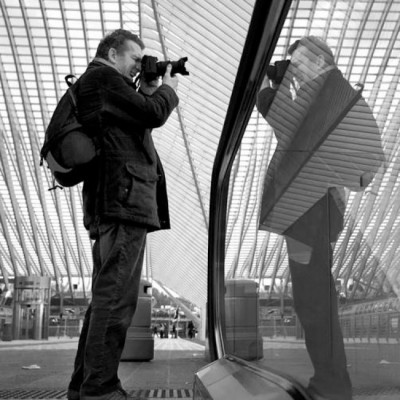SEARCH






|
|
|
|


by Editor Miro Susta
Vanishing points and falling lines shape the effect of a picture on plasticity and dynamics. The image effect therefore depends strongly on the number and position of vanishing points.
What seems simple and logical at first glance is not quite so trivial at second glance.
The images in this article introduce readers to various examples of “Vanishing Point Photography” focusing on architectural, road & railway and nature photography.
Images of geometric, and of course non-geometric shapes, are subject to 2-point perspective in photography. However, only if the camera is perfectly aligned for the horizontal perspective.
Horizontal vanishing points are always at the level of the horizon line.
On architectural photographs, it is usually easy to identify alignment (vanishing points) lines.
In landscape photography, lines and surfaces can become the motif of the design element.

“Autumn Tunnel” by Pawel Uchorczak
The following images show a nearly symmetrical structure with the central perspective. The viewer's attention is directed to the centre of the image via the image diagonal lines (converging lines).
Finally some useful hints facts.
When alignment lines overlap, they form a vanishing point. Vanishing points can be present several times in the picture or outside.
For the majority of emphatically resting motives, the horizon should be approximately in the lower third row.
The linear perspective view has the following properties:
An average photograph has exactly 3 vanishing points. These can be used creatively for image design. The vanishing points are within or very often outside the picture. The ground plane should be parallel to the horizon line, otherwise the image will be crooked (curved).
Basic rule: Horizontal vanishing points are always at the height of the horizon line. These can be inside or outside the picture. Eye level is the distance between the ground surface and the height of the camera or our eyes.
The larger the angle between the alignment lines, the faster objects will appear to be smaller with increasing distance, the perspective becomes steeper.
At a small angle between the alignment lines we are talking about a flat (shallow) perspective.
As soon as you assume an oblique position with respect to an object, the object is displayed with two vanishing points. In general, objects with 2 vanishing points are made more vivid than with only one.
Once you no longer hold the camera horizontally, the last remaining dimension will show alignment lines, the image will have 3 vanishing points.
In pure nature shots, there are perspective lines of light and vanishing points, only these are more difficult to identify, because straight lines rarely occur.
Conclusion
In general, the vanishing points are not about the position of your camera, but about the objects related to your camera.
Each object introduces its own vanishing points, so it is easiest to place them all in rows so they share the same vanishing points.
If you prepare a single perspective grid and pass all the objects to the grid, you get a stiff artificial space; and you will lose control of the composition.
On the other hand, the more points you create, the more chaos and work for you.
Share your vanishing points photos in 1x-gallery.
 | Write |
 | Greetje van Son PRO This is a great overview with really beautifull photography of different objects. Compliments to all photographers and thanks to Miro for sharing this with us.
best regards, Greetje |
 | Yvette Depaepe CREW Thanks for your appreciation, dear Greetje! |
 | Miro Susta CREW Many thanks for your kind words Greetje. |
 | Andreas Agazzi PRO Always nice to read this kind of photo journeys, great examples well explained. Many thanks to Yvette and Miro, also for including an image out of my collection. Well done, best regards! |
 | Miro Susta CREW Andreas, many thanks for your kind words. We appreciate it very much. |
 | Yvette Depaepe CREW Thanks a lot, Andreas ;-) |
 | Catalin Alexandru PRO Thanks Miro for selecting my image for your editorial ! |
 | Miro Susta CREW You are most welcome Catalin. |
 | Thierry Dufour PRO Wonderful images, thank very much to Yvette and Miro !!! |
 | Yvette Depaepe CREW ;-) Thanks, Thierry! |
 | Miro Susta CREW Many thanks for your appreciation Thierry. |
 | Catalin Alexandru PRO Excellent article Yvette and thanks for the selection,much appreciated! |
 | Yvette Depaepe CREW Thanks Catalin! All credits go to Editor Miro Susta for writing this article and selecting images ;-) Glad with your appreciation. Cheers, Yvette |
 | Jef Van den Houte CREW Thanks for the article and for the selection Miro |
 | Miro Susta CREW Many thanks for your nice comment Jef. |
 | Rana Jabeen PRO Well-written article and such a fantastic collection of images showing Vanishing points !! |
 | Miro Susta CREW Thanks for nice words Rana. |
 | Charlaine Gerber PRO Oh what a great article and excellent photos, thank you.... |
 | Miro Susta CREW Thank you very much for your appreciation Charlaine. |
 | Massimo Della Latta Complimenti a tutti, foto splendide |
 | Miro Susta CREW Gracie mille Massimo. |
 | Yvette Depaepe CREW Fine article and gorgeous gallery of 1x images showing great examples of "vanishing points", Miro. Thanks for sharing and congratulations to all the authors. I wish you all a great weekend ahead. Cheers, Yvette |
 | Miro Susta CREW Yvette, many thank for excellent editing and for nice words of appreciation. Wish you also nice and relaxing weekend. |